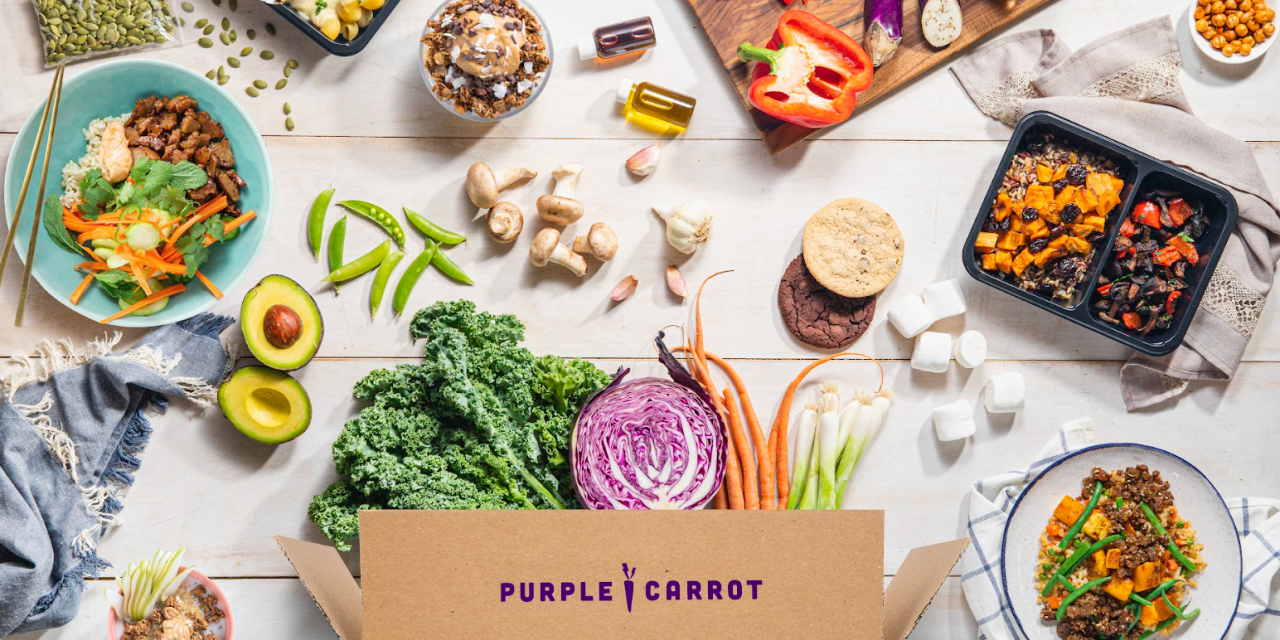How Purple Carrot is moving beyond meal kits with flexible offerings

Meal kit service Purple Carrot is looking to add-ons and themed boxes to drive growth.
Founded in 2014, Purple Carrot specializes in vegan and vegetarian recipes — with most of its recipes incorporating vegetables and plant-based protein bases. In 2019, the company was acquired by Japanese online grocery retailer Oisix Ra Daichi, for $12.8 million. At the time of the acquisition, Purple Carrot was generating $43 million in annual revenue and had 22,000 active subscribers.
Like other online grocery players, Purple Carrot experienced double-digit growth during 2020 and 2021. But going forward, flexibility is the major theme in Purple Carrot’s next phase of growth. The company is aiming to retain customers with new products and services as it aims to ward off struggles with retention that have sunk other meal kit companies, like Blue Apron. So, this year Purple Carrot introduced pantry staples and snacks from third-party CPG brands like cauliflower cracker maker Ground Up Snacks and chocolate brand Goodio. Purple Carrot is also growing its non-dinner offerings by expanding quick-to-assemble breakfast and lunch items, such as sandwiches and grain bowls.
In May, the company announced the appointment of Rishi Bhatia as its new CEO. Bhatia previously held the position of chief technology officer at the company. Since taking on the helm, Bhatia told Modern Retail that he’s been focused on expanding the ways customers use Purple Carrot.
“We want to continue to deliver unique flavors, but also increase our value proposition through convenience and flexibility, as cooking habits evolve,” said Bhatia.
The cost of Purple Carrot’s classic dinner kit ranges from $79.50 to $107, and customers can place orders on a weekly cadence, with the option to skip as many weeks as they want. Each weekly box has three or four meal kits.
In June, the company launched its latest product — Celebration Boxes — which features three-course meals themed around seasonal celebrations or holidays that serve two. For example, customers can order Purple Carrot’s birthday box to cater a birthday party later that week, said Bhatia. These boxes cost $75 and serve two people, and customers can order them on a one-off basis or in addition to their weekly boxes.
Last year, the company also began testing prepared meals — which are cold-packed dishes that cost $12.99 per meal — that are now available on a weekly basis. Unlike Purple Carrot’s classic meal kits, these are ready by microwave in under two minutes.
Andrea Nordby, head of culinary at Purple Carrot, said that add-ons have become a popular option among customers. “We have a rotating set of plant-based staples that customers can add to their boxes,” she said – these include specialty items like plant-based sausage, sauces and tahini. The company is adding dozens of more SKUs to its “Plantry” section in the coming months.
Since 2020, Purple Carrot has also offered frozen vegan meals at grocery stores via a partnership with Conagra. While the meals are a small portion of the company’s business, they help create brand awareness in grocery stores such as Target, Walmart and Whole Foods, among others. “The frozen offerings is one of many ways we’re trying to complement our flagship subscription boxes,” Bhatia said.
Nordby added that the company is trying to attract home cooks who are interested in plant-forward dishes – as opposed to alternatives to animal-based products.
“Overall, the interest in plant-based cooking has been focused on the Beyond Meats and Impossibles of the world,” Nordby explained. “But our recipes are focused on whole foods and seasonal vegetables that add our own twist to it.”
Meal kit companies experienced a boom, thanks to the growth of at-home cooking. A number of players, like HelloFresh and Blue Apron, saw a big spike in new customers during the pandemic, especially when grocery stores and delivery services were strained.
Since then, some of these newly acquired customers have tapered off, as meal kit companies began to run into some of the same issues they faced pre-pandemic – including high supply chain costs and lower-than-expected customer demand. Market leader HelloFresh has held onto its growth trajectory, and the company expects revenue to jump between 20% and 26% in 2022. Blue Apron, meanwhile, continues to grow revenue but with added costs. In the first quarter of 2022, Blue Apron’s net loss hit $38.4 million, compared to $15.7 billion the previous year. Meanwhile, its marketing expenses jumped 40% year-over-year, to $28 million.
Ross Cloyd, director of grocery at Kantar, also noted that food delivery is facing challenges as customers become more price-conscious due to inflation “Price and convenience of the technology will play a major role in consumers’ decision to stick with a delivery service,” Cloyd said.
Thus, Cloyd said, more unique products could help meal delivery companies stand out — whether it’s exclusive chef collaborations or add-ons. Indeed, side dishes and add-ons have become a priority for major competitors like HelloFresh and Blue Apron. The offerings are not only a way to grow box sizes, but cater to customers’ weekly needs, Cloyd said.
At the same time, curated meal kits are becoming more and more competitive within the overall grocery industry. “We’re seeing retailers like Walmart, Kroger’s Home Chef and Publix offering their own to-go kits,” Cloyd said. “That shows that there is still a big opportunity in the category.”
Bhatia, for his part, said that he feels customers keep returning to Purple Carrot for the “unique recipes,” which he feels can be difficult for newer players to replicate from scratch. “I think the combination of delicious meals and unique content will help us grow sustainability in the long run,” Bhatia said.
